To can French Onion Soup, start by caramelizing onions slowly in a sturdy pot with butter and a bit of oil, then add beef broth, water, white wine (optional), bay leaf, and thyme. Taste and season gradually, deglazing as you go. Ladle into sterilized jars, leaving headspace, then process in a pressure canner or following your canning guidelines. When you’re ready to serve, reheat and top with baguette slices and Gruyère. More tips await you below.
Ingredients and Quantity
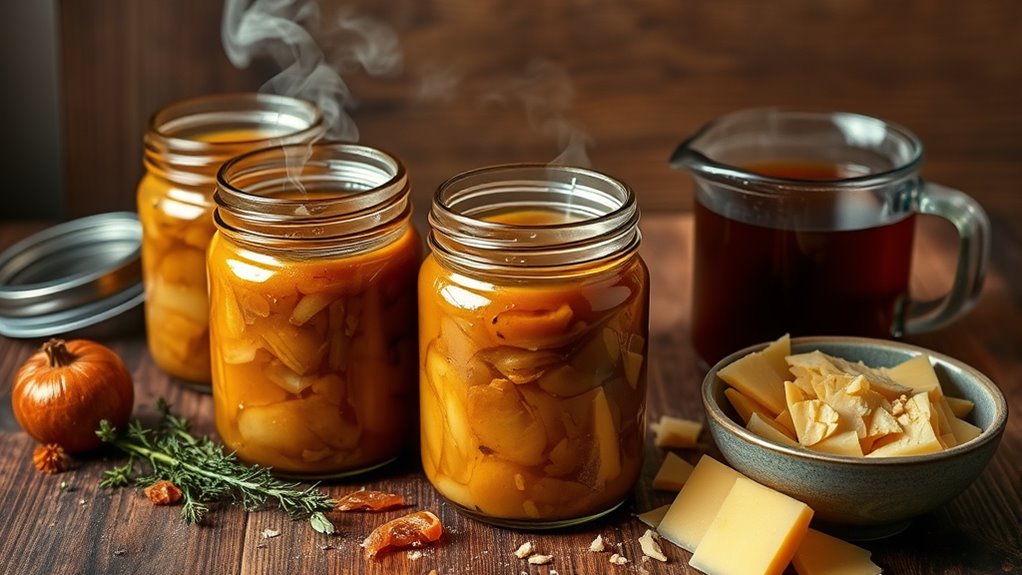
To make French onion soup, gather these ingredients: 4 large onions (about 2 pounds), 2 tablespoons unsalted butter, 1 tablespoon olive oil, 1 teaspoon sugar, 4 cups beef broth, 2 cups water, 1/2 cup dry white wine (optional), 1 bay leaf, 1 teaspoon thyme, salt and pepper to taste, and crusty bread with grated Gruyère for serving. You’ll notice onion types matter: sweet, yellow, and red bring distinct sweetness and bite, shaping soup variations you can craft. Table below highlights quick choices.
| Onion type | Flavor profile |
|---|---|
| Sweet | Mild, caramelizes easily |
| Yellow | Balanced, rich sweetness |
| Red | Peppery finish |
Preparations
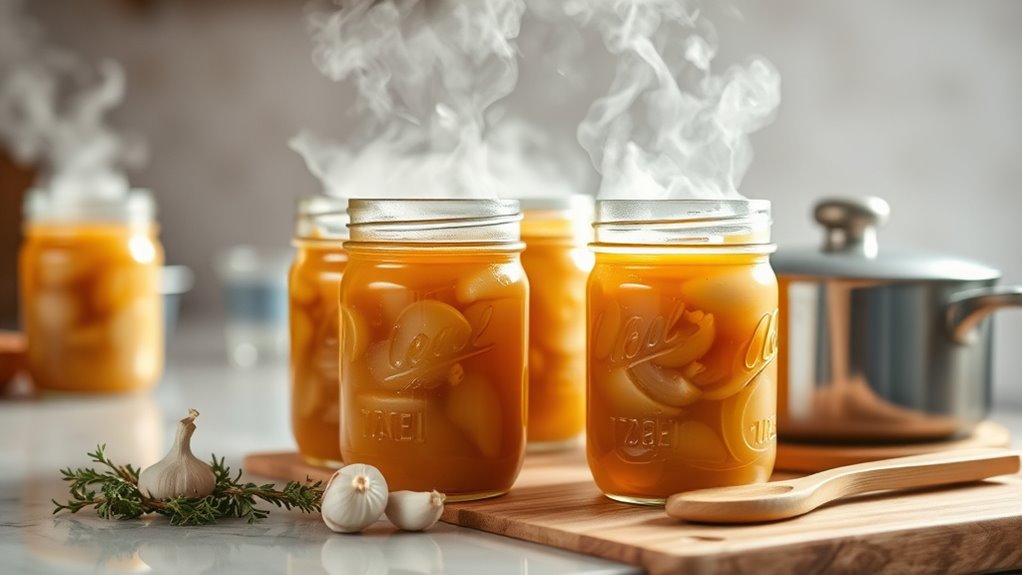
Preparing French onion soup starts by getting your onions ready: peel, trim, and slice them thinly into uniform half-moon shapes so they caramelize evenly.
Preparation methods set the pace for depth and balance, so you’ll control heat, timing, and patience to maximize flavor. You’ll sweat onions gently, deglaze, and build a rich base with stock, wine, and a touch of sugar to encourage browning. Flavor enhancements come from careful seasoning, mindful reduction, and consistent stirring to avoid scorching. Maintain clarity in your steps, and keep notes on timings for future batches.
- Slice uniformly to guarantee even caramelization
- Sweat slowly without browning too quickly
- Deglaze with a small amount of liquid
- Season gradually and taste as you go
Kitchen tools or Kitchenware Required
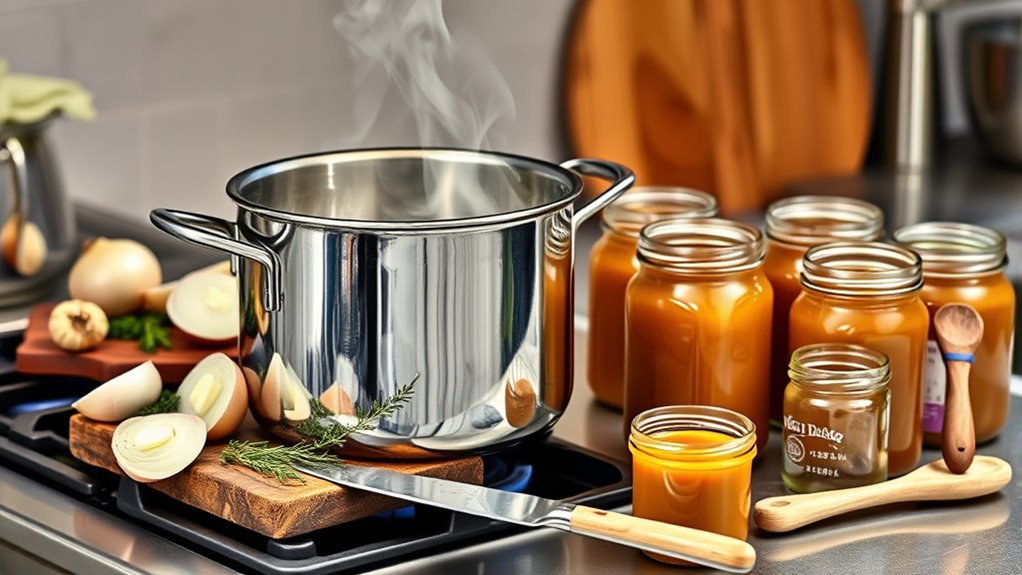
A well-equipped kitchen makes French onion soup easier to master, starting with a sturdy pot or Dutch oven that can handle long, gentle caramelization. You’ll want reliable canning supplies on hand for storage, plus quality cutting tools to prep onions efficiently. These tools keep your workflow smooth and safe as you build flavor. Below is a quick reference table to keep you on track.
| Tool Category | Why it matters | Suggested picks |
|---|---|---|
| Pot/Dutch Oven | Even heat, browning control | Heavy-bottom, oven-safe |
| Knives | Precision cuts, safety | Sharp chef’s knife, paring knife |
| Utensils | Stirring, deglazing | Wooden spoon, silicone spatula |
| Canning Supplies | Storage and preservation | Jar lifter, lids, sterilizer |
| Cutting Boards | Prep surface | Wide, non-slip board |
Canning supplies, Cutting tools.
How to Cook
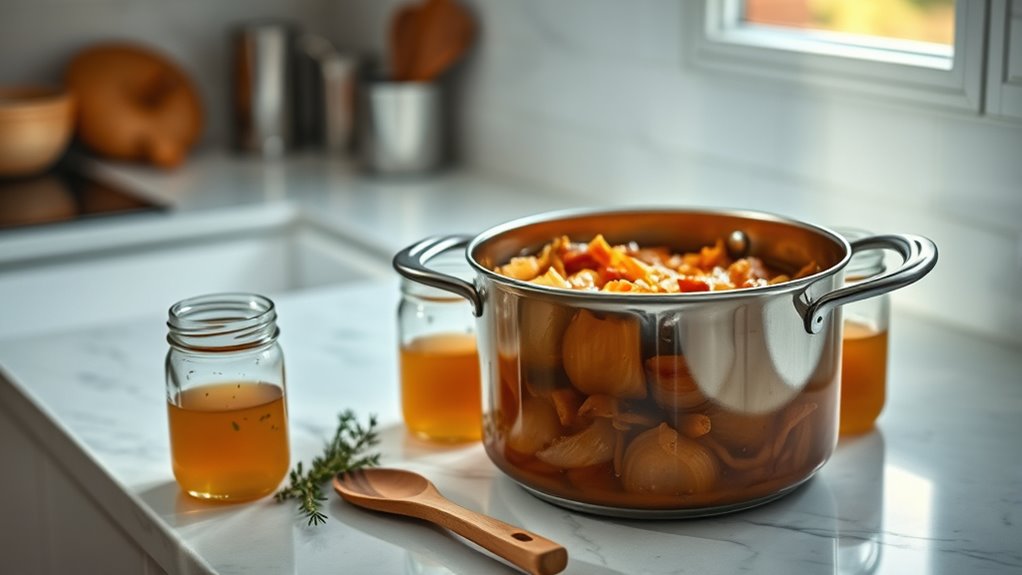
- Gather the right tools for cooking.
- Slowly caramelize onions to build flavor.
- Manage heat carefully to coax out sugars and enhance sweetness.
- Stir steadily to develop depth without burning the onions.
- Deglaze the pan with stock to lift and incorporate browned bits (fond).
- Caramelize onions in batches to ensure even browning.
- Build a flavor foundation using proper aromatics.
- Adjust seasoning gradually, tasting and adding salt, pepper, and thyme for balance.
- Aim for consistent color and rich, jammy onions as the soup base.
- Finish with a precise simmer to marry all components and aromas.
How to Serve
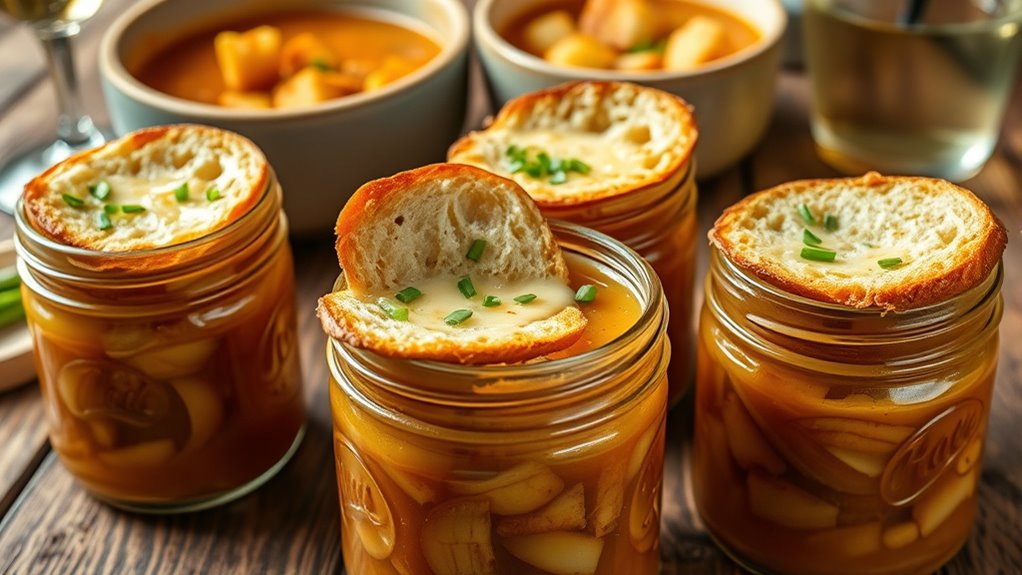
To serve French onion soup, ladle the hot broth into bowls and guarantee each portion includes a generous amount of caramelized onions. You’ll want bowls that retain heat and resist cracking, so guests stay warm. Offer a firm slice of baguette on top, or place toasted croutons for texture. Serve with a light sprinkle of grated cheese, then broil briefly to melt and form a bubbling top. For serving temperature, aim for steaming-hot broth without scorching tongues. Present the pot with a ladle nearby so guests can adjust portions. Serving suggestions include pairing with a crisp side salad or dry white wine. Garnish options range from fresh chives to a pinch of cracked black pepper, enhancing aroma and balance.
Tips
For tips, start by choosing a reliable onion variety and cooking method to build a strong, sweet foundation; use low, steady heat to caramelize evenly without burning. You’ll optimize flavor with patience, controlling moisture and stirring routinely to prevent scorching. Focus on canning techniques that maintain texture while concentrating sweetness, and avoid overcooking to prevent mush. Preserve aroma by deglazing with a splash of broth or wine before canning, so flavor blooms in each jar. Plan your timing around pH and processing guidelines, keeping safety at the forefront. Your aim is bold, clean stock in every batch, ready to enrich soups or stocks later.
Caramelize onions patiently, deglaze for aroma, and can with care for bold, sweet stock.
- Choose onions with consistent size and high sugar content
- Maintain steady caramelization, avoiding sudden heat spikes
- Deglaze properly to capture fond and aroma
- Label jars with date and batch details
Food Value and Benefit
French onion soup offers more than just a rich and comforting flavor; it provides valuable nutrients that contribute to your overall health. This prepared dish combines the nutritional benefits of onions with a savory broth, making it a wholesome choice.
Benefits of eating French onion soup include:
- Supports digestive health thanks to dietary fiber.
- Boosts the immune system with vitamin C.
- Helps maintain fluid balance and proper nerve function due to potassium content.
- Provides sulfur compounds that aid metabolism and offer antioxidant properties.
- Delivers a low-calorie option that helps manage energy intake.
- Encourages nutrient retention even after cooking and storage, preserving health benefits.
Key vitamins and minerals in this recipe:
- Vitamin C: Supports immune defense and skin health.
- Potassium: Essential for electrolyte balance and nerve signaling.
- Sulfur compounds: Contribute to metabolic processes and antioxidant activity.
Enjoying French onion soup allows you to nourish your body with a flavorful, nutrient-rich dish that supports your wellness goals without sacrificing taste.
Frequently Asked Questions
How Long Does Home Canning Preserve Flavor?
Home canning preserves flavor for about one year if you store properly in a cool, dark place; flavor preservation remains strongest early on, so use shelf life as a guideline and check jars for quality before serving.
Can I Reuse Onion Skins for Color?
Yes, you can reuse onion skins for color, though results vary. Onion skin benefits show subtle tones; for natural dyeing, simmer skins separately, strain, and use the liquid promptly to avoid dull colors that fade with time.
Is a Pressure Canner Safer for Onions?
Yes, a pressure canner is safer for onions if you’re preserving them, because it reliably reaches temps that inactivate botulism. For onion preservation, follow guidelines, vent properly, and use a tested pressure canning procedure.
What if Jars Seal Poorly After Processing?
If jars seal poorly after processing, you’ll recheck lid placement and band tension, then perform jar troubleshooting and reseal with proper sealing methods, reprocessing if needed. You’ll trust tested times, then enjoy safe, preserved freedom with certainty.
Can I Double the Batch for Storage?
Yes, you can double the batch for storage, but adjust your batch size to fit your canner and jars. Follow safe processing times, and use proper storage tips to keep flavor and texture consistent.
